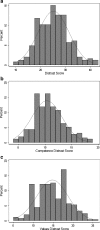Development of a revised Health Care System Distrust scale
- PMID: 18369678
- PMCID: PMC2517896
- DOI: 10.1007/s11606-008-0575-3
Development of a revised Health Care System Distrust scale
Abstract
Context: Growing evidence suggests that most forms of distrust are multidimensional, including domains of technical competence and value congruence. Prior measures of health care system distrust have not reflected this multidimensional structure and may be limiting research into the role of health care system distrust in health and health care in the US.
Objective: To develop a revised a scale of health care system distrust.
Design: Three phase study, including focus groups, pilot testing and a cross-sectional telephone survey.
Participants: A total of 404 individuals recruited directly from the Greater Philadelphia area or through the University of Pennsylvania Health System.
Results: Multilevel consensus coding of focus group transcripts identified 2 primary domains of competence and values with the values domain having subthemes of honesty, motives, and equity. Iterative testing of the initial 76 items led to a final scale of 9 items with a Cronbach's alpha of 0.83. Factor analysis demonstrated a 2-factor structure, corresponding to the domains of values and competence. The values subscale (5 items) had a Cronbach's alpha of 0.73 and the competence subscale (4 items) had a Cronbach's alpha of 0.77. These psychometric properties were similar among African Americans and Whites.
Conclusions: A novel 9-item scale of Health Care System Distrust with high reliability allows the assessment of the 2 primary domains of distrust (values and competence) and may facilitate research in this area.
Figures
References
Publication types
MeSH terms
Grants and funding
LinkOut - more resources
Full Text Sources
Medical


